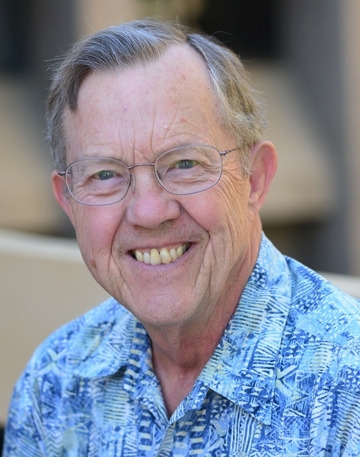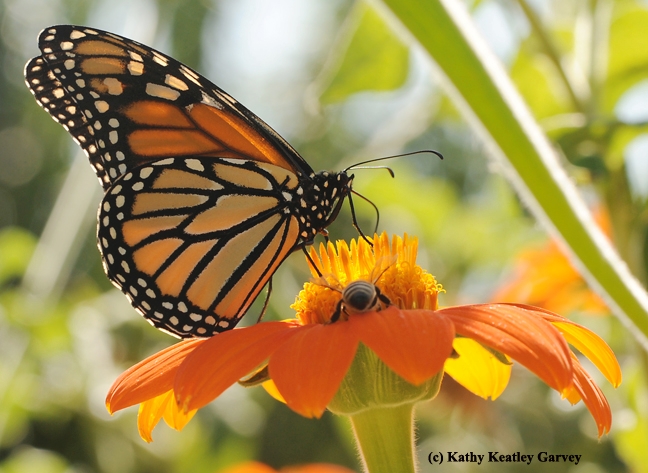
Dingle, who served as a professor in the UC Davis Department of Entomology from 1982 to 2002, achieving emeritus status in 2003, recently published the second edition of Migration: The Biology of Life on the Move (Oxford University Press), a sequel to the first edition published in 1996.
A worldwide authority on animal migration, Dingle says the full understanding of migration, or “life on the move,” involves genetics, physiology, and morphology, as well as behavior and ecology. Among the animals that migrate: whales, monarch butterflies, armyworm moths, pelicans, locusts, winged aphids and ballooning spiders.
Dingle has researched in seven countries: UK, Kenya, Thailand, Panama, Germany and Australia, as well as the United States. National Geographic featured him in its cover story on “Great Migrations” in November 2010. LiveScience interviewed him for its November 2010 piece on“Why Do Animals Migrate."
Now Dingle will be heading to the Pacific islands to study monarchs. He just received the UC Davis Edward A. Dickson Professorship Award to research “Monarchs in the Pacific: Is Contemporary Evolution Occurring on Isolated Islands?”
Monarch butterflies established just 200 years ago in remote Pacific islands are undergoing contemporary evolution through differences in their wing span and other changes, Dingle believes. He will be working with community ecologist Louie Yang and molecular geneticist Joanna Chiu, assistant professors in the UC Davis Department of Entomology and Nematology, to examine the ecology and physiology of monarch butterflies (Danaus plexippus) in three islands where contemporary evolution might be expected. The islands are Oahu (Hawaii), Guam (Marianas) and Weno (Chuuk or Truk).
“This is the necessary first step in a long-term analysis of the evolutionary ecology and physiology of monarch butterflies on remote Pacific islands,” said Dingle, a fellow of the American Association for the Advancement of Science and the Animal Behavior Society.
The monarch, widely distributed “for eons” in the New World, is fairly new to the Pacific islands and to Australia. He speculates that the monarchs arrived in the Pacific islands with their host plant, milkweed, which was valued at the time for its medicinal properties.
An analysis of a monarch population in Hawaii shows that resident monarchs have shorter, broader wings than the long-distance migrants. The Hawaii butterfly wings were shorter than the eastern U.S. long-distance migrants, but “not so short-winged as the residents in the Caribbean or Costa Rica, which have been present in those locations for eons, rather than the 200 years for Hawaii.”
“If there are indeed wing shape changes associated with evolution in isolation, are there other changes that may have occurred under selection and local adaptation for residency?” Dingle wonders. “Are there other changes that may have occurred under selection and local adaptation for residency? Examples of such traits might be changes in flight muscle physiology, changes in photoperiodic diapause response, changes in the characteristics of orientation ability and its relation to antennal circadian rhythms, or changes in the reproductive capacity or tactics (re-colonization of ‘empty' habitats is no longer part of the life cycle)."
“Diapause and fat storage, necessary to support migration, are triggered by short photoperiods,” Dingle said, “and the butterflies orient using a sun compass synchronized to a circadian rhythm in the antennae." Overwintering sites in North America include the Transvolcanics Mountains of central Mexico, and the California Coast, particularly Santa Cruz, Pismo Beach, and Pacific Grove.
The UC Davis team will study the monarchs on the three islands and compare them with California mainland monarchs. Using an image analyzer and camera equipment available in Yang lab, the team will photograph “chilled” butterflies in a fixed position with wings spread and then release them back into the wild. The image analyzer will measure different variables, including length, width and angles from the photographs and compute multivariate-shape parameters.
The Chiu lab will assess genetic differences using a transcriptomic approach with monarch caterpillars. “This assessment will be greatly facilitated by the fact that the monarch genome has now been sequenced,” Dingle noted. “A major focus of Dr. Chiu's research is circadian rhythm genes, and these will be especially relevant here because of the association of these genes with monarch capabilities. Because the monarch cell line is cycling and has a functional circadian clock, effects of mutations in specific clock genes can be examined with regard to clock function.”
Dingle expects the one-year research program not only to form the basis for “long-term research on the evolutionary genetics of behavior, ecology and physiology on Pacific island monarch butterflies” but on “the general aspects of island biogeography, a subject of great practical theoretical interest in evolutionary biology.”
That's exciting research. We look forward to the results!
Attached Images:
